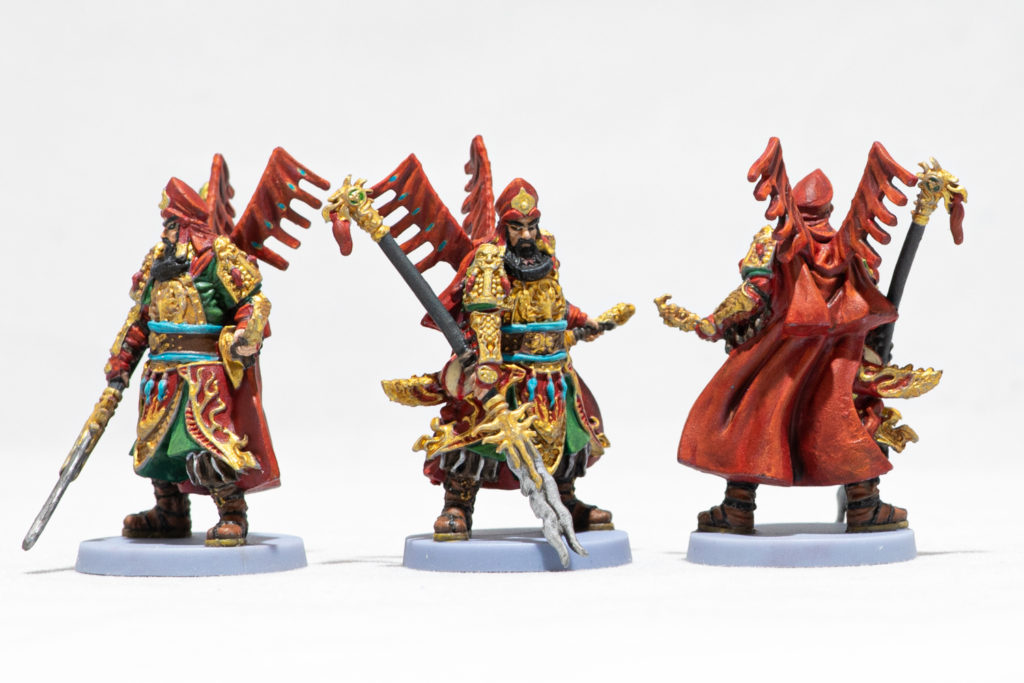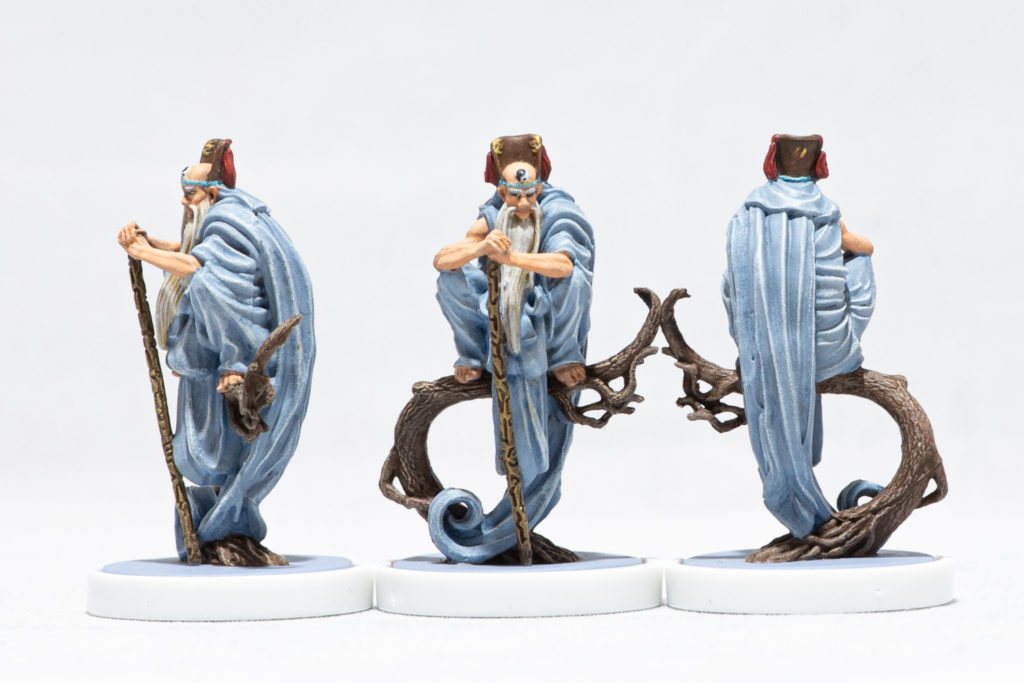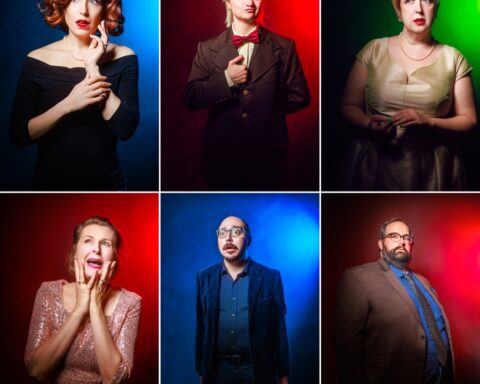Rising Sun is a tabletop game about samurai and Japanese mythology designed by Eric M. Lang and produced by CMON. The game was released alongside an expansion called Dynasty Invasion, which featured two additional player clans, Sun and Moon. These clans looked very different from the samurai clans in Rising Sun, and initially I wasn’t excited to paint them because if they didn’t come from Japanese myth and legend, I didn’t understand what they were doing in a game about samurai. Then one day I stumbled upon something that changed my perception: the game’s artist Adrian Smith had buried the inspirations for each figure in the filenames on his art page. As I looked up each name, I discovered that (with one exception) the Dynasty Invasion clans were all based on characters from the fourteenth-century Chinese novel Romance of the Three Kingdoms (the game describes them as samurai clans from across the sea).
I searched for an audiobook that I could listen to as I painted. I couldn’t find a good recording of Romance of the Three Kingdoms, however I did discover the excellent Three Kingdoms Podcast, a passion project by John Zhu, who narrates the story of the novel in detail, and who provides maps and commentary to help the listener follow the story. As I painted the figures, I listened to the narrative and became enthralled with the stories of all the characters that the Dynasty Invasion clans were based on and came to learn about this fundamental work of Chinese literature. The podcaster John Zhu explains that whereas in Western culture, words and references from Shakespeare permeate English language and metaphors, in China, expressions and symbols from Romance of the Three Kingdoms do the same for the East. Thus began the journey.
Moon Clan

Guan Yu
The look of the daimyo of the Moon Clan is based on Guan Yu, one of three sworn brothers—including Liu Bei and Zhang Fei—who made an oath to one another in the peach orchard, vowing eternal friendship and steadfastness. In the novel, Guan Yu bore the Green Dragon Crescent Blade and was one of the fiercest warriors to fight on the side of Liu Bei against, well, pretty much everyone, but especially the prime minister Cao Cao, and later their former ally Sun Quan. The Moon Clan daimyo was the first of the clan figures I painted and perhaps among my favorite I’ve done. Here is Adrian Smith’s official art for the character.
Liu Bei
The second figure I painted was one of the Moon Clan bushi, based on Liu Bei, a former cobbler who claimed descent from the Han Dynasty and is arguably the protagonist of Romance of the Three Kingdoms. Kind of. In the novel, we wields two swords, just as he is sculpted. Thanks to his claim of nobility, Liu Bei is the central figure among the three sworn brothers, and Guan Yu and Zhang Fei serve him. Here is the game art.

Zhang Fei
Zhang Fei is the rabble rouser of the three sworn brothers in Romance of the Three Kingdoms. Boisterous and hot tempered, he’s often spoiling for a fight in the first part of the novel. Here he is pictured with his weapon of choice from the novel, the “long serpent spear.” He’s the second of the Moon Clan bushi models. Game art for Zhang Fei.

Zuo Ci
The Moon Clan shinto figure is based on Zuo Ci, who is kind of a mischievous old wizard who shows up in the midst of Romance of the Three Kingdoms, creates trouble for our antagonist Cao Cao, and then vanishes. He’s a bit of a humorous aside in the course of the novel. The toughest part of painting him was giving him a blind left eye and painting the yin-yang symbol on his brow (still not sure how I did it). Zuo Ci game art.


Sun Clan

Daji
The Sun Clan daimyo is based on Daji, a courtesan of the Shang court in the last days of the Shang Dynasty (around 1100 BC). She is the only one of these figures that wasn’t in Romance of the Three Kingdoms, having lived nearly a thousand years before the time in which the novel is set (around AD 200). In myth and legend, she is a capricious nine-tailed fox taking the form of a human and bringing the dynasty to ruin. In the Rising Sun game, however, the Sun Clan is among the most honorable of the clans at the start of the game. This figure was especially challenging to paint, owing to the freehand symbols I painted across her robes. Daji game art.
Dian Wei
The first Sun Clan bushi is based on Dian Wei, bodyguard of the prime minister Cao Cao in Romance of the Three Kingdoms. Dian Wei was so strong he could wield two halberds, one in each hand. Dian Wei game art.

Gan Ning
In Romance of the Three Kingdoms, Gan Ning is an ex-pirate who kept up a flashy appearance and wore bells so that his victims could hear him coming. He was a crack shot with the bow, and he served Sun Quan—at first against Cao Cao at Red Cliff and later against Liu Bei’s allies. In Rising Sun, he is the second Sun Clan bushi. I found him difficult to paint for all of that color but rose to the challenge of freehanding a pattern on his sash. Gan Ning game art.

Lady Zhurong
The Sun Clan shinto is based on Lady Zhurong, who was said to have been descended from a fire deity, and she wielded “flying daggers.” Like Zuo Ci, she appears only briefly in Romance of the Three Kingdoms, causing trouble for Liu Bei and his allies who are trying to conquer her lands. The reds, yellows, and oranges took a long time to blend, but in the end, she is one of my favorite figures I’ve done. Lady Zhurong game art.


Wrapping Up
I painted these clans in February and March of 2021. Each finished figure was another step toward completing Rising Sun. Each one felt like a tangible goal that could be accomplished in a week, and as each one was finished, and each clan was finished, pandemic time flowed by. I finished the Three Kingdoms Podcast as I did the final blending on the Sun Clan shinto. After such a long journey, I missed the characters and their stories, so after I had finished, we rewatched John Woo’s Red Cliff, to familiarize ourselves with the way most of these characters were portrayed on film.
The month of April has been about tasks and responsibilities and preparing for whatever the end of the pandemic will mean. I miss the quiet nights listening to the stories of these ancient Chinese heroes and villains while coloring in the details of the models.






























Follow Me